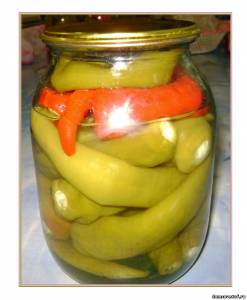Ingredients: hot pepper
Time to Bookmark: Summer, Autumn
Five useful properties hot pepper
The American Indians were the first to grow capsicum, and it came to the countries of Europe and Asia relatively recently - in the 16th-17th centuries. But these days it's even hard to imagine Indian, Korean or Chinese cuisine without characteristic burning taste. Unique properties hot peppers are gradually gaining more and more fans around the world. Why is this happening?
Hot peppers contain many vitamins useful for the body - C, group B and carotenoids. It is interesting that in a lemon there is half as much vitamin C as in raw hot pepper pods. In addition, pepper has fixed oils and sugar.
The sharpness of pepper directly depends on the alkaloid capsaicin, which is part of it, and this substance is able to relieve pain and reduce inflammation.
Thanks to bitter pepper, endorphins are produced in the body - hormones of happiness, joy and pleasure. They reduce stress and help to cope with insomnia.
For many years it was believed that eating spicy food is harmful. Recent studies by scientists say the exact opposite. Hot pepper improves appetite and, if consumed in large quantities, qualitatively normalizes digestion.
Eating hot peppers is especially beneficial in old age. It improves metabolism and blood circulation, normalizes blood pressure, and also prevents the development of atherosclerosis and reduces the risk of blood clots. 
Types of hot pepper and safety during its processing
There are only four cultivated types of hot pepper: Peruvian, Mexican, Colombian and pubescent. Over the years, by crossing them, people have grown a great variety of varieties that differ in pungency, taste, size, shape of the pods and their color. Some peppers taste almost spicy, and some varieties seem to burn with fire.
The main thing in which all peppers are similar is that they have a sharp, burning, slightly bitter taste. Therefore, in cooking they are trying to use in a small amount, as a seasoning for salads, first and second courses, and less often - for pastries and drinks.
When processing hot pepper care must be taken. Burning substances, falling on the mucous membranes or micro-wounds on the hands, can cause pain and a strong burning sensation. Therefore, when harvesting pepper, the room should be well ventilated. It is advisable to wear gloves on your hands. In addition, you should try not to touch your face with your hands, and even more so your eyes. If pepper does get into the eyes, they must be rinsed with plenty of water. 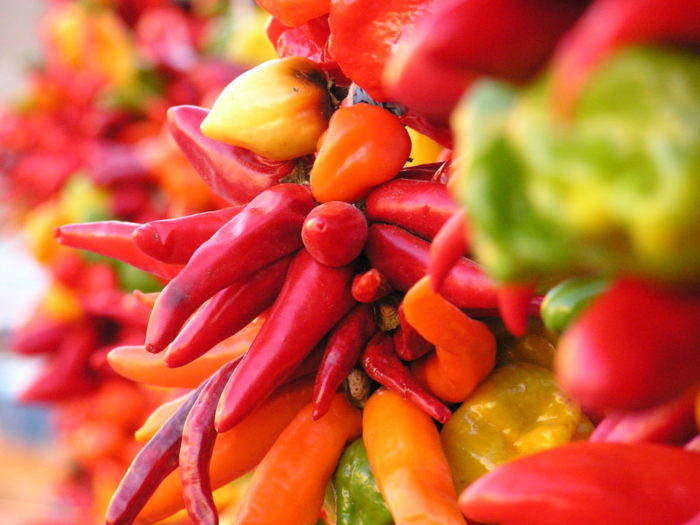
Ways to dry hot peppers
Bake for about 20 minutes and serve immediately. Chicory, orange and walnut salad for 4 people. Wash the chicory and cut the leaves. Peel the oranges and carefully remove the raisins to leave only the fruit. Removing the orange colored sugar will also remove the pulp. mix Orange juice with honey, vinegar and season with some salt. Mix the chicory with the resulting dressing. Decorate with earthen walnuts and parsley.
Cocoa coffee - Have you heard of it?
If you have not yet heard of chicory coffee, you have probably heard, even drunk as a child, Inca coffee, in which the root of this vegetable is the main ingredient. Coffee made from chicory root dates back to the 17th century. However, chicory chicory has its fans today, especially in France, Belgium, and the southern United States, where the drink is known as "New Orleans" coffee. Chicory root can also be found as one of the ingredients in coffee substitutes.
Keep hot pepper dried it is very convenient, and there are several ways to dry it. At the same time, you can dry both whole pods and halves of peppers with seeds already removed.
The easiest way is to hang the pods on ropes or strong, harsh threads. You just need to choose a well-ventilated room, a country terrace, a canopy, an attic or a loggia, where it is dry and warm. It is also desirable that the direct rays of the sun do not fall on the pepper. It is convenient to string the pods through the stalks. It is necessary to ensure that they do not touch each other, and the air can blow over them from all sides.
It is also convenient to spread the peppers on trays covered with paper, small grills and big dishes anywhere, for example, on a wide windowsill. The main thing is not to forget to stir up the pepper "raw materials" from time to time.
To speed up the drying process, the pods are placed in a stovetop oven or electric dryer. With this method, it is important to choose the optimal drying mode so that the pepper dries and does not bake. In the oven, it is good to set the temperature to + 50 ° C and slightly open the door. In an electric dryer, peppers of the desired condition can be obtained in about 12 hours.
Chicory is rich in vitamins
During the cold winter months, chicory is an excellent source of vitamins. And while you won't provide much energy, it will give you high doses of beta-carotene and potassium. Beta-carotene is good for the eyes, and potassium is essential for normal functioning cells in the body, particularly muscle and nerve.
Tips for buying and storing chicory
Color is an important factor in determining the quality of a Belgian endive. Chicory should be white with yellow leaves, and if their edges are green then it will be even more bitter - it all comes down to during cultivation. In this regard, chicory he prefers to be in the dark. For those who prefer less bitter, we have another tip: buy a chicory variety that has red leaves, a hybrid created from two varieties of vegetables. Once purchased, chicory should be stored in the refrigerator.
Store dried pods whole or ground. To grind them, they usually use a food processor, coffee grinder or mortar and pestle. Dried pepper does not like moisture, so you need to store it in hermetically sealed containers: glass jars, wooden boxes, birch bark tubs or paper bags. Many people leave a string with pods in a conspicuous place - to decorate the kitchen. 
Pickling
There is a saying among the inhabitants of the Caucasus: “Nothing warms you on cold days like a good spicy snack". Pickling peppers is not difficult. For 1 kg of capsicum you will need: a large bunch of dill, cilantro and mint, 3 heads of garlic and 300 ml of grape vinegar. Most a good option for pickling - this is vinegar, which is made from white grapes. In addition, when pickling, black and allspice peas are used, Bay leaf, cloves, coriander, salt and sugar.
It will keep fresh for up to 18 days in a regular refrigerator compartment, and it will stay fresh for up to 27 days in a refrigerator compartment. Pepper simply belongs to our kitchen. In a famous fairy tale, the inhabitants of the kingdom suffered from a lack of salt and were ready to balance with gold. It is indispensable in the kitchens of the world, and different kinds Peppers provide a special flavor to many dishes. Indeed, the fact that pepper makes up over 30% of the total spice trade speaks for itself. His sharp, spicy taste was appreciated in ancient Greece, Rome and Asia Minor, where it was imported from India.
Fully ripened peppers taste very good. Ideal - plucked directly from the bush just before pickling. Of the greens, only leaves are used, sprigs for pickling are not needed. You don't need to cut the greens. Garlic simply needs to be disassembled into cloves without peeling it. Then, in combination with pepper, it will serve as an excellent savory snack. 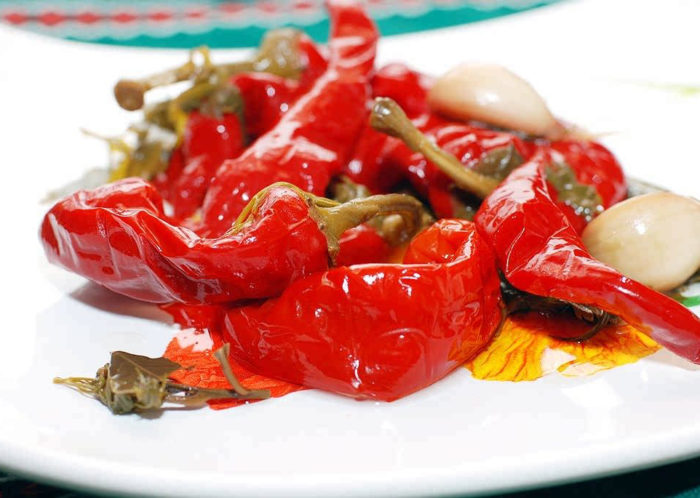
The pods are washed and pierced at the stalk with a toothpick or knife so that there is no air inside the peppers. The next task is to slightly soften the pods. To do this, they are placed in a pot of water, boiled water is poured into it and kept under a closed lid for 3-4 minutes. Then the water is drained. This must be done at least three times. This method will allow the peppers to become softer, but not lose their shape. The same result can be achieved if the pods are blanched in boiling water for 2-3 minutes, and then turn off the heat and leave them in the pan under the lid for another quarter of an hour.
First the Arabs, later the Venetian merchants, controlled the trade in this spice. Their clients were German merchants a century later, and from there pepper went to the Czech lands. Together with other exotic cultures, we reached the trade routes along the Elbe and the Vltava. The use of pepper in our country was not always the same. Sometimes he was very popular and his consumption was great, sometimes it was as if he had retreated. These fluctuations have also been affected by how peace or war rages. A variety of peppers were available in the century, especially black and white ones.
Forman cars from Italy were imported to us. Traders were squashed in the shop in large mortars and sold on paper in paper towels. These include accelerating metabolism, promoting digestion and appetite, cardiac and vascular system, against flatulence. This is due to the effects of alleviating menstrual pain and is also considered a natural aphrodisiac. In the Middle Ages, even the Church opposed the use of pepper. Its representatives were convinced that pepper contributes to the lust of the body.
Jars for pickling are sterilized in advance. For 1 kg of peppers, you will need 3 cans of 0.8 liters or 5 - 0.5 liters each. 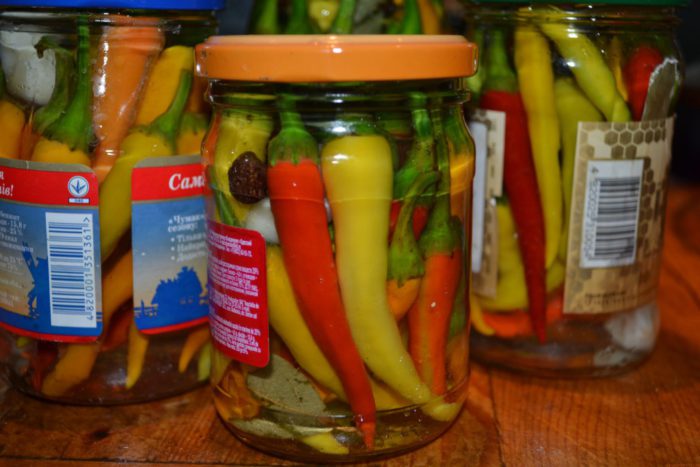
After all the preparation, you can start preparing the marinade. In 1.5 liters of water put 6 tsp. granulated sugar, salt the water to taste, add all the leaves from the greens, garlic cloves, 6-8 bay leaves, 15 black peas and 5-6 peas of allspice, 1 tbsp. l. coriander seeds and 4-6 cloves. The marinade is boiled and poured into it. grape vinegar. Then the marinade should boil for a couple more minutes.
For its antibacterial properties, it helps, for example, in the cold. In green pepper, in addition to black, there are two phenolic substances that act against certain strains of bacteria. Despite all the positive effects, caution should be exercised when consuming pepper.
Pepper: black pepper - four in one
Its excessive consumption can lead to an increase blood pressure, and some types of pepper cause blockage of urine. The pepper that spices up the dishes can come from different types plants. The most famous is black pepper. It originates in Southeast Asia and is now grown in tropical regions of the world, mainly in tea or coffee plantations. Here he is the best, he is a vine that needs support and is thus associated with other plants. Of course we get black pepper, but also green, white and red.
Green leaves, along with garlic, spread on the bottom glass jars. Peppers are placed on top of them and the contents are poured with hot marinade with spices to the very top. After that, the banks are corked. You can store them at room temperature.
salting
Salting is a great way to harvest for the winter, because it allows you to save a maximum of vegetables in vegetables. useful vitamins and minerals. Hot peppers can be salted in different ways.
Black pepper is obtained by drying raw berries in the sun until the initially reddish skin is dark in color. Another option is the treatment method by short immersion in boiling water and further drying in dryers. Black pepper has its typical distinctive taste, especially for soups, sauces and dark meats.
If needed Green pepper, unripe green berries are dried quickly at high temperatures and then either chilled or loaded into saline or vinegar infusions. The taste of green pepper will be appreciated mainly by gourmets and is commonly used, for example, in the preparation of steaks and delicacies such as pasta.
If the house has the ability to store food in a cool room, for example, in a cellar, hot pepper pods can be salted without rolling them into jars. Peppers are pre-baked in the oven to become soft, and allowed to cool. Then the pods are placed in pre-sterilized dry jars, placing peeled garlic cloves, dill sprigs, horseradish and black currant leaves between the layers of pepper.
White pepper is the ripe fruit of the pepper. The berries get wet, so the red skin is easier to peel and then dry. Its taste is also characteristic, but more subtle, often used in light and creamy sauces, cheese, poultry or fish. Not everyone has a slightly dull taste for white pepper.
Red peppers are perfectly ripe pepperoni. Immediately after harvesting, they must be loaded into different types infusions. Red peppers are often used to make grilled, marinade or steak sauces. pink pepper not real pepper. We see this in the form of multi-colored peppers where it is very small and the slightly sweet gum-like flavor balances out the typical taste of other peppers.
To prepare the brine, 60 g of salt (not iodized!) and 80 kg of vinegar are diluted in 1 liter of water. The water is boiled, allowed to cool and poured into jars of pepper. Under oppression, the pickle is left at room temperature for three weeks, and then taken out to the cold. 
If there is no cellar or a cool veranda in the house, the jars are filled with hot brine, a little vinegar is added and sterilized: 0.5 l for 20-25 minutes, and 1 liter for 35-45 minutes. After that, the jars are closed with lids. You can store them at room temperature.
Pink pepper is more decorative because it is toxic in large quantities. It has a sharp, slightly sweet flavor and is especially used in typical Indian dishes, wine or cheese sauces. In our country it is not well known, and dried long fruits peppermint look like a lamb. Cubic pepper, also called taut, originates in the East Indies. Unripe fruits are dried by the stem in the sun. It is more aromatic and pungent than black pepper. However, the difference is what makes the spicy taste.
While black pepper contains piperine, Cuban pepper has cubes inside. It is not just a spice in the true sense of the word, it is also used as an ingredient in perfumes, liqueurs, it is known as a folk remedy. It has a disinfecting and dehydrating effect on the body. In the kitchen, cubic pepper is used primarily for game, cheese, and dark meats.
pepper paste
Hot pepper pastes are used in the cuisines of almost all Asian countries and many Mediterranean countries. They are already added to ready meals, as well as when cooking soups and while stewing meat and fish. For fragrant spicy pasta you only need five ingredients: 100 g of hot pepper, 1 kg bell pepper, 5 heads fresh garlic, 2 tbsp. l. salt and 5 tbsp. l. vegetable oil. You can add cilantro, celery, or mint to add different flavors to your pasta.
Succhuan pepper is one of the oldest Chinese spices, also grown in Indonesia, Japan and Vietnam. It is part of a five-flavor Chinese blend. It tends to have a bitter taste and lemony aroma and is hotter than black pepper. It is especially suitable for the treatment of poultry.
They are dried with fine and very hot chili peppers. They originally grew up on the Cayenne River in present-day French Guyana. The Czech name is part of a bad translation. Ground pepper loses its taste and flavor quite quickly. Therefore, it is ideal if we use freshly ground or crushed peppers in the kitchen. It is advisable to add it to food immediately before the end of the heat treatment. The quality of the pepper is also different. We will find it with simple test. Take a glass of water and pour some peppers into it.
Both types of peppers are washed and de-seeded. Garlic is also cleaned. Then the peppers and garlic are crushed in a blender or food processor until homogeneous mass. The resulting puree is spread in cheesecloth and hung up so that the juice flows. It should never be thrown out! Pepper juice can be frozen in small serving containers such as ice cubes and used as a condiment during the winter months.
If they are good, they should sink to the bottom. If they float on the surface, the spice is hollow and therefore poor. This results in a reduced flavor, so much more needs to be used to achieve the same flavor as when using quality spices.
Beef baked with green pepper sauce
Various types of peppers can be used in the kitchen in many ways, not just as food supplement to improve their taste, but also as a main component of the taste of many recipes. You can take some advice. Beef fried with green pepper sauce - procedure.
The drained puree is transferred to a baking sheet, salt and oil are added to it and mixed thoroughly. In an oven heated to +150°C, pepper paste is cooked for about an hour. Store it in small plastic containers in the freezer. Opened pasta should be refrigerated and used within 10 days. 
Preserving hot peppers without salt
Hot pepper itself is an excellent antimicrobial agent. That is why it is consumed in large quantities in southern countries. Because of their antimicrobial properties, pepper cuts can be made with unusual preservatives.
Dry, dry and cut into pieces of cattle sausage in several places, the oil is poured and left for several hours to leave. We can also lightly brush them with pressed garlic. Bake the meat on both sides for 3 minutes. Pour the wine into a dish, mix in the green peppers and boil for a short time. Pour cream and concentrate. Appropriate accompaniments are toast or American potatoes and a vegetable side dish.
Chocolate mousse with red pepper
Chocolate mousse with red pepper - procedure. Prepare simmering cream vanilla sugar, add the hot chocolate chips and stir until the chocolate has melted. Add the egg and mix it into the liquid. Prepare the hard whipped cream and gradually stir it into the warm chocolate mixture. Place the resulting foam in bowls or cups and leave to cool, ideally in the refrigerator. Serve with whipped cream and red pepper flakes.
To preserve hot pepper without salt and vinegar, first you need to wash it, dry it and pierce it with a toothpick. Then sterile jars are filled with whole pods and cold-pressed olive oil is poured on top. If desired, you can add a little spicy herbs to the pepper. Banks are closed with lids and stored in a dark place. With this type of preservation, olive oil acquires a bright peppery aroma and becomes spicy in taste. Therefore, it can be used in winter as a salad dressing.
Asparagus with White Pepper Hollandaise Sauce
Asparagus with white pepper hollandaise sauce - procedure. white asparagus completely exfoliated, green only in the lower third. Each type of asparagus is cooked separately in salted water with added sugar. White cook about 15 minutes, green about 10 minutes. After cooking, remove them and keep them warm. In the meantime, we chop the finely chopped basil. We add it slowly to the mixture of egg yolks and nine tablespoons of asparagus broth that we found in a water bath. Add chopped capers, ham and basil.
In another way, hot peppers are preserved with natural apple cider vinegar. The preparation of pods and jars is the same as for oil preservation, only the pepper is poured not with oil, but with vinegar. As in the first case, to it, if desired, you can add spices- mint, rosemary or oregano, as well as honey - 2 tbsp. l. for 1 liter jar. The pepper will be ready to eat in a month. And fragrant and spicy vinegar, like oil, is perfect for dressing fresh salads. 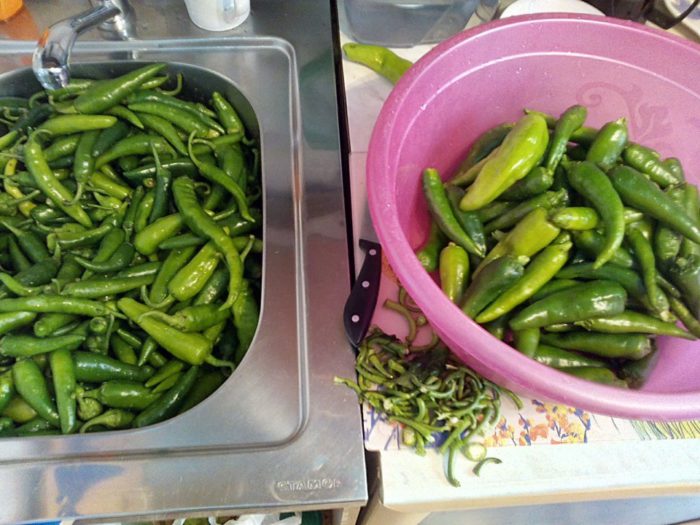
![]()
Mix, season with white pepper, salt and lime juice. Place the potatoes and asparagus on a plate and pour over the sauce. Hot asparagus can be sprinkled with finely chopped hard cheese before pouring the sauce. Last hot days perfect time for serving cold salads.
When you order a Caesar salad at a restaurant, you can also get it with chicken. AT original recipe instead of croutons, anchovies or a fried baguette, it contains no poultry! Romaine lettuce 150 g parmesan cheese 2 egg yolks garlic cloves four sardines baguette slices a spoonful of dijon mustard a spoonful of semolina salad 100 ml salt olive oil and ground pepper. Mince garlic and anchovy slices. Cut the lettuce into small pieces so that there is no need to press it into the mouth. Then prepare the bandage.
spices on liter jar:
Salt - 1 teaspoon
1/2 teaspoon essence
Handle peppers with rubber gloves.
Wash the pepper, remove the seeds, put it in a bowl and pour boiling water over it, put it under heavy oppression for four to five hours so that the bitterness subsides. Then drain the water, put pepper in jars, add spices and pour boiling water over it. Sterilize for 30 minutes, twist, no need to wrap.
Hot Pickled Peppers
For lovers of hot pepper we offer hungarian recipe(According to reviews, it turns out very tasty).
Ideally, for this recipe, it is better to use a variety of pepper called apple paprika. This is a fleshy pepper shaped like an apple. If you can’t find such a pepper, use ordinary hot capsicum, but you can also make it with sweet paprika.
Ingredients:
Hot chilli pepper
Brine:
Water - 1 liter
Sugar - 7-8 tablespoons
200-250 ml. vinegar 9%
Salt - 3 tablespoons
1 aspirin
Be sure to wear rubber gloves. Remove seeds from peppers, cut in half, wash and place in jars. Boil the brine, cool. Put the peppers in a saucepan, pour over the brine, cover with foil and leave overnight. During this time, the pepper will absorb water and the amount of brine will decrease. If there is not enough brine, cook more. Place peppers in sterilized jars, fill with brine, add aspirin and close with lids.
Pickled hot pepper
For a liter jar:
Hot pepper - capsicum
Garlic - 4-5 cloves
Salt - 1.5 teaspoons
Black pepper - 5-6 peas
70% Acetic essence- 1.5 teaspoons or 55 ml. (9% vinegar)
Bay leaf - 2 leaves
Dill (for salting)
Cooking:
Put spices in a liter sterilized jar: garlic, pepper, bay leaf, dill. Wash the pepper and put it in a dense layer in jars, pour boiling water over it, add salt and essence and let it cool a little. Then set to sterilize for 10 minutes. Then roll up. Turn the jars upside down, wrap and leave until cool. Then take it out to the cold.
I found another one interesting recipe but didn't use it myself. Hot pepper is prepared as described above, only the amount of water poured is divided in half with apple cider vinegar(preferably homemade, find out how) and peppers are poured with this brine. The next day, you will have ready-made pickled peppers. If anyone tries this recipe, please leave your feedback.
Hot chilli pepper for the winter
Ingredients: